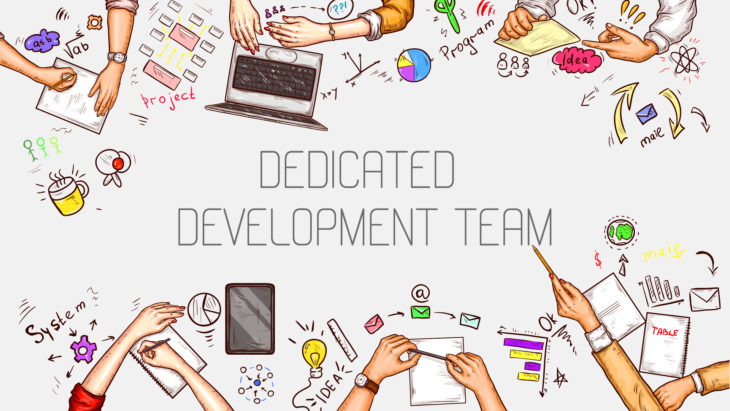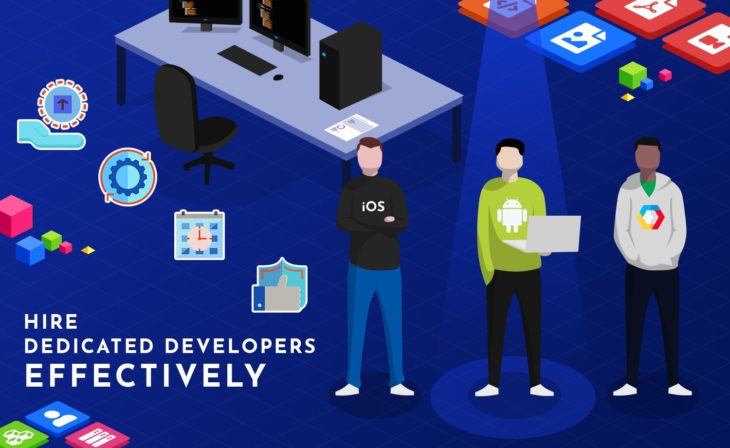Not all development work can (and should) be completed by an in-house team. Keeping a large number of in-house coders is not always beneficial for business, so it makes sense to delegate a part or even all tasks to an external development unit. However, the team’s expansion with extra developers does not mean the need to mess with freelancers; a beneficial and universal solution is to hire a dedicated team. Experts of Qubit Labs share their experience and tips on an efficient, time-effective, and safe process of recruiting dedicated developers.
Dedicated Developers – Who Are They?

Source: Hacker Noon
As soon as one starts thinking of an alternative to in-house team, the first idea coming to mind is hiring a freelancer. Nevertheless, not all businesses are ready to work with freelancers for security reasons. More than that, it is very hard to motivate and control freelancers working individually from their homes or private offices. Thus, such model of team augmentation does not work well for many.
A sound alternative to dealing with freelancers is the recruitment of a dedicated team – a service that has become immensely popular among global businesses. A dedicated team of developers works in an outsourced location in the vendor’s office. This means that for the developers, the work schedule does not differ from full-time employment – they attend the office, have a team’s office, are hired officially, and receive their social package and additional perks, just as any in-house employee does. The difference is huge for the client only – the company does not have to relocate employees, provide for their living and ensure the office space and equipment for them. The client hires a team according to the project needs and signs a contract with the staffing vendor like Qubit Labs, while the latter hosts the client’s team and provides all office supplies and equipment for them.
How to Hire Dedicated Developers?

Source: The NineHertz
To make sure that the process of hiring a dedicated team goes smoothly and the vacancy is closed in record time, our experts recommend following a certain algorithm:
1. Choose location
There are numerous regions with a focus on IT outsourcing varying by the programmer rates, working conditions, and vendor support. We recommend scanning the market first to identify the location in which you wish to hire before proceeding to in-depth talent search.
2. Choose vendor you could build the most trusty relations with
You can surely involve in the talent search and recruitment processes on your own, but is it worth the trouble? It’s much better to find a suitable vendor in the destination country and task it with the recruitment procedures.
It’s very important to build solid, trust and long-term relationships with the vendor you are going to choose. You should clearly understand the criteria your vendor should meet to be a part of your business like flexibility, fast and tuned recruitment and retention processes, a clear and structured each client’s business needs understanding, ability to keen on the latest technology field trends to provide each potential client with high-quality consulting. And Mobilunity team possesses all the features above and shares them with more than 100 clients from different European regions to help their business grow and develop faster.
3. Define requirements

Source: developeronrent.com
It’s possible to find the proper programmer meeting your project goals and complying with requirements only if you specify the task clearly and comprehensively. Always provide the vendor with exhaustive detail on the hard and soft skills, tech stack, experience, and seniority level of the candidate you are searching.
4. Meet your recruitment team
The vendor will assign a recruiter (or a recruitment team in case you need many developers at once) to your project. We recommend keeping in regular contact with them to control the process of recruitment, answer all emerging questions, and interacting closely for quicker vacancy closures.
5. Check pre-screened CVs
Once the recruiters compile the set of developers’ CVs for you, it’s your turn to screen them and select the appropriate candidates for a job interview. Study the CVs carefully to weed out the unsuitable ones before the interviewing stage begins – it will save you tons of time afterwards.
6. Interview developers
Interview the selected candidates to see whether they fit your job. Pay attention to the skills that you consider strategic for your project; keep in mind that they have to possess sound soft skills to integrate into your in-house team well.
7. Hire developer

Source: Jelvix
Once you make up your mind which programmer suits you most, notify the vendor and it will conclude the contract with the selected staff.
8. Conduct on boarding
Make sure you make the new offshore team acquainted with your in-house development staff and on board all new developers effectively. This initial step will ensure a better fit of two teams and their fruitful collaboration.
9. Manage team
Don’t forget that a dedicated team also needs HR management; dedicate enough time to it along with your in-house team’s management practices.
10. Don’t neglect staff retention

Source: Syntactics, Inc.
It’s critical to make employees satisfied so that they do not leave.
As you can see, hiring an offshore development team is a serious business in which it’s better to partner with the best staffing vendors to avoid staff turnover or hiring an unsuitable programmer.
